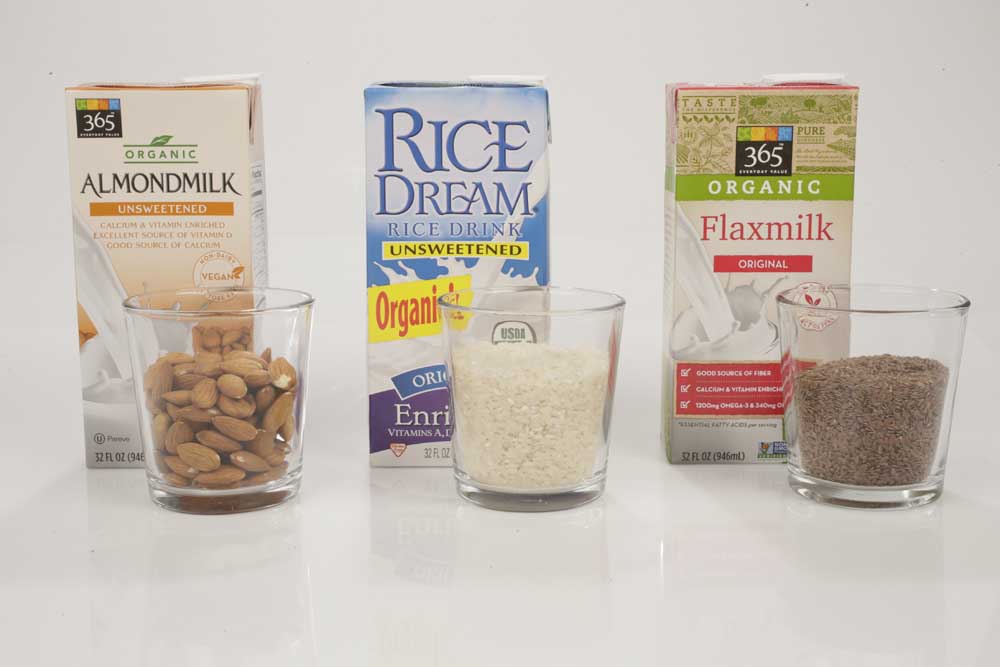Milk alternatives vary
Published 12:00 am Monday, February 17, 2014

- Rob Kerr / The BulletinMilk alternatives, from left: 4) Almond milk; 5) Rice milk; 6) Flax milk.
Peruse most supermarkets today and you will find an abundance of milk that doesn’t come from a cow. There’s milk made from soy, almonds, hemp seed, rice, coconut, sunflower seeds and other ingredients.
People search for alternatives to traditional milk for a variety of reasons. Some people are lactose intolerant, some are vegan or following a dairy-free diet and others simply don’t like the flavor.
But with so many nondairy choices available, picking the right milk alternative can be confusing.
Julie Hood Gonsalves, a registered dietitian and an associate professor of human biology at Central Oregon Community College, helped us sort through the options. In general, she said, milk alternatives “have come a long way” in terms of taste and selection.
When selecting a nondairy option, Hood Gonsalves suggests people consider what role milk plays in their diets. “It depends on the person and what they need,” she said. Are you using a glug of milk in your morning coffee or does milk account for a large proportion of your daily protein and calcium intake? Children, in particular, tend to fall into the latter category.
“Since calcium and protein are the most important nutrients we’d be expecting to find in this food group, those are what we would be looking for in substitutes,” Hood Gonsalves said. (Whole cow’s milk has 148 calories, 7 g fat, 8 g protein, 300 mg calcium and 12 g sugar per 8-ounce serving.)
While many nondairy choices are fortified with calcium and vitamin D, many do not have as much protein as milk. She also cautions individuals to watch for sugar, which is often added to improve flavor.
Hood Gonsalves also points out individuals can try to make their own nondairy milk. “You can make substitutes with about anything … add water, let it soak, blend and strain. The taste, the texture, the nutrient availability are all dependent on what you start with and whether it is fortified,” she said.
Nutrition values among milk alternatives vary depending on the particular manufacturer; many of these nondairy drinks are also fortified with additional nutrients and vitamins. The following information is a basic guide. •
Basis for comparison: whole cow’s milk
Nutrition per 8-ounce serving: 148 calories, 7 g fat, 8 g protein, 300 mg calcium, 12 g sugar
Pros: The protein found in milk is a complete protein, which means it has all of the essential amino acids needed to build proteins for the our body.
Cons: The fat found in milk is primarily saturated fat, which has been shown to increase cholesterol levels; some people have difficulty digesting lactose, the sugar found in milk.
1) Hemp milk
Nutrition per 8-ounce serving: 80 calories, 7 g fat, 2 g protein, 300-400 mg calcium (if fortified), 1 g sugar (14 g if sweetened), 0 g fiber
Pros: The fat in hemp milk (which is made from legal hemp seed) is primarily unsaturated and contains a large amount of omega 3, good for inflammation and heart disease. Unsweetened versions contain little sugar.
Cons: Not a good source of protein. In general, this can be an expensive choice.
Taste: Rich and creamy.
2) Soy milk
Nutrition per 8-ounce serving: 70 calories, 4 g fat, 8 g protein, 300-550 mg calcium (if fortified), 3 g sugar (12 g if sweetened), 2 g fiber
Pros: Soy is one of the rare nondairy choices that is high in protein. The fat in soy milk is also good, as it is primarily unsaturated and also contains some omega 3 fatty acids.
Cons: The protein is not nearly as complete as cow’s milk.
Taste: Thick and creamy consistency, similar to whole milk. Nutty flavor. Can be substituted for milk in most savory recipes, although since it adds some soy flavor, not a best pick for desserts.
3) Coconut milk (not canned)
Nutrition per 8-ounce serving: 45 calories, 4.5 g fat, 0 g protein, 300-400 mg calcium (if fortified), 7 g sugar
Pros: Relatively low in sugar. The fat is saturated, but new evidence suggests it is not unhealthy like other saturated fats.
Cons: No protein.
Taste: Creamy and rich with a bit of coconut flavor. Good in coffee or tea as well as by the glass. Substitutes well in baking, but adds a sweet coconut flavor.
4) Almond milk
Nutrition per 8-ounce serving: 40 calories, 3 g fat, 1 g protein, 300-400 mg calcium (if fortified), 1 g sugar (15 g if sweetened), 1 g fiber
Pros: The fat is primarily unsaturated. If unsweetened, almond milk is a very low-sugar choice.
Cons: Protein levels are very low and the protein is not complete.
Taste: Sweet and nutty. Goes well in tea or coffee as well as in cereal. Also a good baking substitute, although it will add a hint of almond.
5) Rice milk
Nutrition per 8-ounce serving: 70 calories, 2 g fat, 1 g protein, 300-400 mg calcium (if fortified), 13 g sugar, 0 g fiber
Pros: Low in fat; relatively inexpensive for a milk alternative.
Cons: Very high in sugar and very low in protein.
Taste: Sweet and rather thin — almost watery and light — in consistency. Some people think this is the best milk for replicating a glass of milk. Works well as a milk substitute in desserts, but is too sweet for most savory preparations.
6) Flax milk
Nutrition per 8-ounce serving: 30 calories, 2.5 g fat, 0 g protein, 300-400 mg calcium (if fortified), 0 g sugar (8 g if sweetened), 3 g fiber
Pros: Contains Omega 3s. High in fiber.
Cons: Very little protein.
Taste: Neutral flavor with some body.
Source: Nutrition information provided by Julie Hood Gonsalves, the USDA and manufacturers’ information






